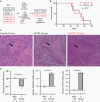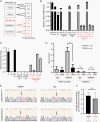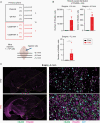TERT promoter C228T mutation in neural progenitors confers growth advantage following telomere shortening in vivo
- PMID: 35325218
- PMCID: PMC9713509
- DOI: 10.1093/neuonc/noac080
TERT promoter C228T mutation in neural progenitors confers growth advantage following telomere shortening in vivo
Erratum in
-
Corrigendum to: TERT promoter C228T mutation in neural progenitors confers growth advantage following telomere shortening in vivo.Neuro Oncol. 2022 Nov 2;24(11):2008. doi: 10.1093/neuonc/noac178. Neuro Oncol. 2022. PMID: 35876482 Free PMC article. No abstract available.
Abstract
Background: Heterozygous TERT (telomerase reverse transcriptase) promoter mutations (TPMs) facilitate TERT expression and are the most frequent mutation in glioblastoma (GBM). A recent analysis revealed this mutation is one of the earliest events in gliomagenesis. However, no appropriate human models have been engineered to study the role of this mutation in the initiation of these tumors.
Method: We established GBM models by introducing the heterozygous TPM in human induced pluripotent stem cells (hiPSCs) using a two-step targeting approach in the context of GBM genetic alterations, CDKN2A/B and PTEN deletion, and EGFRvIII overexpression. The impact of the mutation was evaluated through the in vivo passage and in vitro experiment and analysis.
Results: Orthotopic injection of neuronal precursor cells (NPCs) derived from hiPSCs with the TPM into immunodeficient mice did not enhance tumorigenesis compared to TERT promoter wild type NPCs at initial in vivo passage presumably due to relatively long telomeres. However, the mutation recruited GA-Binding Protein and engendered low-level TERT expression resulting in enhanced tumorigenesis and maintenance of short telomeres upon secondary passage as observed in human GBM. These results provide the first insights regarding increased tumorigenesis upon introducing a TPM compared to isogenic controls without TPMs.
Conclusion: Our novel GBM models presented the growth advantage of heterozygous TPMs for the first time in the context of GBM driver mutations relative to isogenic controls, thereby allowing for the identification and validation of TERT promoter-specific vulnerabilities in a genetically accurate background.
Keywords: TERT promoter; genome editing; glioma; neural progenitor cell; telomerase.
© The Author(s) 2022. Published by Oxford University Press on behalf of the Society for Neuro-Oncology. All rights reserved. For permissions, please e-mail: journals.permissions@oup.com.
Figures






Comment in
-
A promising preclinical model for TERT promoter mutation in glioblastoma.Neuro Oncol. 2022 Dec 1;24(12):2076-2077. doi: 10.1093/neuonc/noac167. Neuro Oncol. 2022. PMID: 35780432 Free PMC article. No abstract available.
References
-
- Arita H, Narita Y, Fukushima S, et al. . Upregulating mutations in the TERT promoter commonly occur in adult malignant gliomas and are strongly associated with total 1p19q loss. Acta Neuropathol. 2013; 126(2):267–276. - PubMed
-
- Körber V, Yang J, Barah P, et al. . Evolutionary trajectories of IDHWT glioblastomas reveal a common path of early tumorigenesis instigated years ahead of initial diagnosis. Cancer Cell. 2019; 35(4):692–704.e12. - PubMed
Publication types
MeSH terms
Substances
Grants and funding
LinkOut - more resources
Full Text Sources
Molecular Biology Databases
Research Materials
Miscellaneous

